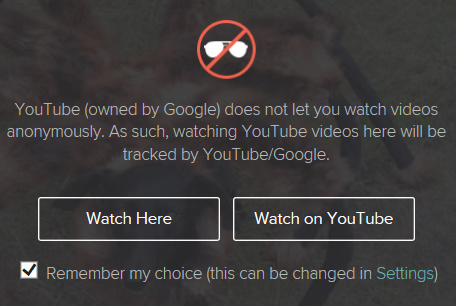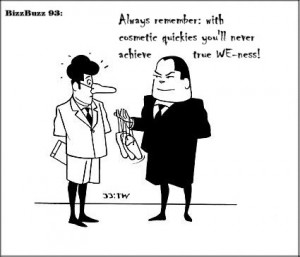|
|
|
Archive for September, 2014
Tuesday, September 30th, 2014

Just as people are hard wired to respond to attractiveness they harbor other biases.
And just as the bias for attractiveness is anthropological, not biological, so are other biases.
Biases are fueled by assumptions, which are rarely logical—or conscious.
Google, along with most of tech, is rife with biases—both pro and con.
The idea of unconscious bias came to the attention of Google HR boss Laszlo Bock via a story in the New York Times about the biases among American university science professors regarding the difference in competency between female and male students (the women were ranked as less competent).
Unconscious bias, the sometimes useful tendency to make snap judgments (that subway car is empty for a reason), guides us into unexamined bigotry (she’s a woman, not a leader).
Google being Google they approached the situation using a combination of education—not just for executives and managers, but for everybody—
plus four specific steps to identify and deal with unconscious bias;
- Gather facts.
- Create a structure for making decisions.
- Be mindful of subtle cues.
- Foster awareness. Hold yourself — and your colleagues — accountable.
Google’s efforts are driven by competitiveness, as opposed to political correctness.
“If we have an employee base that reflects our user base, we are going to better understand the needs of people all over the world,” said Brian Welle, the researcher in charge of Google’s diversity training workshops. “Having people with a different worldview and different ways of solving problems gives you the raw materials to be more innovative and to be able to solve problems that nobody has asked before.”
Flickr credit: Don Graham | YouTube credit: Life at Google
Posted in Culture, Ducks In A Row, Hiring, Personal Growth | 1 Comment »
Monday, September 29th, 2014

$97 million doesn’t sound like much today, but it was a lot 15 years ago when Microsoft lost a lawsuit and was forced to reclassify it’s contractors as employees.
Back then Microsoft called them “permatemps.”
These days startups of all kinds are relying on freelancers to drive their growth, so many that a new term was coined.
They’re called 1099 contractors and the over-all approach is termed the 1099 economy.
“The most famous examples of 1099 companies are on-demand car providers like Uber and Lyft, but there are dozens of others: Homejoy, Handy, Postmates, Spoonrocket, TaskRabbit, DoorDash, Washio.”
The Feds, in the person of the IRS, are very particular when it comes to classifying employees as independent contractors or freelance.
Behavioral control refers to facts that show whether there is a right to direct or control how the worker does the work. A worker is an employee when the business has the right to direct and control the worker. The business does not have to actually direct or control the way the work is done – as long as the employer has the right to direct and control the work.
The financial control factors fall into the categories of:
- Significant investment
- Unreimbursed expenses
- Opportunity for profit or loss
- Services available to the market
- Method of payment
I’m a long way from being an expert, but after reading through the IRS information at least some of these companies are going to be in trouble.
Uber sets prices, discounts, doesn’t reimburse expenses and terminates drivers who also work for any of the competition.
That’s a lot of control in the light of the IRS rules.
Obviously, any company that can eliminate payroll, taxes and benefits is going to be super profitable—at least until they have to follow the rules like everybody else.
Flickr image credit: 401kcalculator.org
Posted in Compensation, Culture | 2 Comments »
Friday, September 26th, 2014
A Friday series exploring Startups and the people who make them go. Read all If the Shoe Fits posts here
 For many founders speed and as-instant-as-possible gratification are their watchwords. For many founders speed and as-instant-as-possible gratification are their watchwords.
They aim to be a rocket and when it doesn’t happen quickly they are on to the next idea.
Now look at the father and two sons who founded and built Qualtrics.
Two years ago Qualtrics had bootstrapped its way to $50 million in revenue, 200 employees, 3,800 customers and a $500 million acquisition offer.
CEO Ryan Smith is all of 33, which means he was just 23 when the company started just after the dot com crash (dad created the product and his older brother powers the tech.)
He turned the buyout down and took investment instead.
Two years later they have over $100 million in sales, 550 employees, 6,000 customers, a billion dollar valuation and $150 million in a series B round.
It’s said the best time to start a company is during tough times when money is tight.
Qualtrics may not have been built fast, but it was certainly built to last.
Image credit: HikingArtist
Posted in If the Shoe Fits | No Comments »
Thursday, September 25th, 2014

Do you need to code to manage software developers?
Do you need to know circuit design to manage hardware engineers?
If you answered ‘yes’ then you’ve bought into one of the most common myths of management.
It exists because people are commonly promoted within the department in which they were originally hired.
But not always.
Neha Sampat is not only a woman, but also CEO of cloud software firm Raw Engineering, where, among other things, she runs a team of web developers.
She is not technical and certainly doesn’t code.
She attribute her success to the culture she’s built and her attitude towards her people.
“If you have the right people and the right personalities on a team, it’s magic. The smartest thing I have done in my career has been to surround myself with people who are experts in areas I know nothing about.”
Of course, that requires being secure enough in your own skills and hiring choices that you don’t need to be the smartest person on the team.
The same applies to KG Charles-Harris Charles-Harris (who, as his time permits, contributes here). He is a serial entrepreneur and founder/CEO of Quarrio, which just won the 2014 Overall Winner & Most Disruptive awards given by the Software & Information Industry Association (SIIA) in the “NextGen” Big Data category.
KG puts enormous time and effort into hiring the right people, then gets out of their way and trusts them to get the job done.
Or as Sampat says,
“I am very deliberate about expressing how much I value people’s knowledge and their presence on my team.” (…) “My job is to be an enabler and to give my people the resources they need to make things happen.”
Good management and communication skills are as crucial to success as good coding—perhaps even more so in the long run.
Flickr image credit: Juhan Sonin
Posted in Communication, Entrepreneurs | 1 Comment »
Wednesday, September 24th, 2014
Last week in The Hypocrites of Tech we found that while companies’ push tech for your kids, e.g., Apple iPads, the CEOs, e.g., Steve Jobs, seriously limit their kids’ use of tech.
Tech is making deep inroads to every part of our educational system, but there’s nothing altruistic about it.
They do it to reap the reward of the tsunami of personally identifiable information they get on your kids, with nary a restriction in place—although that’s changing.
Technology companies are collecting a vast amount of data about students, touching every corner of their educational lives — with few controls on how those details are used.
Legislators in the state [California] passed a law last month prohibiting educational sites, apps and cloud services used by schools from selling or disclosing personal information about students from kindergarten through high school; from using the children’s data to market to them; and from compiling dossiers on them.
I use DuckDuckGo for search, because I don’t believe that it’s any of Google’s business where I go on the Net—but Google doesn’t approve.

Fortunately for Google tracking, slicing and dicing their customers/users isn’t bad; that’s because evil, as in the motto “Don’t be evil,” is a fluid term, while Facebook is famous for doing first and apologizing later.
Then there is Apple.
If I ever break down and get a cell phone it will be an iPhone, but not because of the bells, whistles and apps.
It will be because of the privacy statement made by Tim Cook.
Our business model is very straightforward: We sell great products. We don’t build a profile based on your email content or web browsing habits to sell to advertisers. We don’t “monetize” the information you store on your iPhone or in iCloud. And we don’t read your email or your messages to get information to market to you. Our software and services are designed to make our devices better. Plain and simple.
One very small part of our business does serve advertisers, and that’s iAd. We built an advertising network because some app developers depend on that business model, and we want to support them as well as a free iTunes Radio service. iAd sticks to the same privacy policy that applies to every other Apple product. It doesn’t get data from Health and HomeKit, Maps, Siri, iMessage, your call history, or any iCloud service like Contacts or Mail, and you can always just opt out altogether.
I understand that there are people who don’t care about being tracked or seeing ads based on what’s in their email.
But the more people are subject to stalking by marketers, the more they learn about how their data is used and the more they see how the EU reigns in the same companies the more they are demanding similar safeguards.
For now, it’s wise to remember the old saying, “If it seems too good to be true it probably is.”
The bottom line is simple; when it comes to most of the free goods and services, especially those involving social media, caveat emptor.
Image credit: MAPping Company Success
Posted in Business info | No Comments »
Tuesday, September 23rd, 2014

When I’m writing for a client I lose track of time; I don’t even notice when someone walks into my office.
It’s called being “in the zone” and it happens when you are seriously interested and deeply engaged with what you are doing.
Mihaly Csikszentmihalyi, a psychologist at the Claremont Graduate University, has been studying this latter phenomenon for decades. He calls it flow: the experience we have when we’re “in the zone.” During a flow state, people are fully absorbed and highly focused; they lose themselves in the activity.
It’s a proven fact that self-control is mentally fatiguing, but new research shows that high interest results in lower mental fatigue.
Bosses who use contests and gamification to drive interest are missing a good understanding of today’s workforce—and it’s not about age or even self-interest.
People get interested because a project is meaningful and they can see how their work contributes to the larger picture.
Even on minor projects they can see how what they did helped achieve the outcome.
No busy work; no incomplete information and no doing [whatever] for the sake of doing it.
In short, if you want to generate interest in a task it must be meaningful and provide an opportunity for the worker to add value.
Flickr image credit: Beverley Goodwin
Posted in Ducks In A Row, Personal Growth | No Comments »
Monday, September 22nd, 2014

Does your company have soul?
Or is it so focused on profit that there is no room for anything else?
What does it mean for a company to have soul?
That question is addressed by a Belgium, Frederic Laloux, who quit McKinsey when he found himself miserable and out of touch with his clients.
“The work I had loved so much was work I simply couldn’t do any longer. I came to the realization that I was in a very different place than the executive teams of the large corporations with whom I had been working. I just couldn’t work with these big organizations anymore. They felt too soulless and unhealthy to me, too trapped in a rat race of just trying to eke out more profits.”
Wondering what gave a company soul fueled two years of research that resulted in Reinventing Organizations: A Guide to Creating Organizations Inspired by the Next Stage of Human Consciousness.
Not surprisingly, Laloux found that trust ranked at the top of managerial attitudes that create soul.
Trust, Mr. Laloux found, is perhaps the most powerful common denominator in the companies he studied. “If you view people with mistrust and subject them to all sorts of controls, rules and punishments,” he writes, “they will try to game the system, and you will feel your thinking is validated. Meet people with practices based on trust, and they will return your trust with responsible behavior. Again, you will feel your assumptions were validated.”
In other words, bosses (like most others) get what they expect.
While trust can’t be faked, it is trust a function of individual bosses, from the most junior all the way up to the CEO.
That means that even if you are working in a soulless situation you can run your own organization with trust, integrity and soul.
Flickr image credit: Lars Plougmann
Posted in Culture, Personal Growth, Reviews & Recommendations | No Comments »
Friday, September 19th, 2014
A Friday series exploring Startups and the people who make them go. Read all If the Shoe Fits posts here
 Rarely do I see new products that I really want. Rarely do I see new products that I really want.
Most are in the category of ‘nice, but no big deal’—but now and then…
I see something I would love to have, as I did on BI earlier this week
Image credit: HikingArtist
Posted in If the Shoe Fits, Innovation | No Comments »
Thursday, September 18th, 2014
 What makes a hit a hit? What makes a hit a hit?
When you’re ridding a comet of popularity and constantly need to release a new, better version does it make sense to take a step back and garner outside to better understand why your product is hot?
Or are you confident enough in your vision that you feel it’s unnecessary?
Would it surprise you to know that the success of the iPhone was due to the very feature Steve Jobs belittled in his competitors?
Size.
People became blackberry addicts because they could do more on the larger screen.
The iPhone’s screen was substantially larger than Nokia.
Can you even imagine surfing the Net, watching videos or streaming a movie to a phone with a screen like these?

In hindsight, it’s not weird that Jobs might have been wrong about consumer preference for screen sizes in the four years following his death. Rather, it’s weird that he didn’t acknowledge that the iPhone’s (relatively) big screen size was actually driving its popularity while he was alive.
The iPhone is arguably one of Jobs’ greatest hits, yet he never really understood why—because the ‘why’ clashed with his vision.
To acknowledge something you need to be aware of it.
And no matter how good you are at seeing around corners, you may need to modify your own vision to respond accurately to what your market craves.
Image credits: @Samsung Mobile PH and Jorge Barrios via Wikimedia Commons
Posted in Entrepreneurs, Innovation | 1 Comment »
Wednesday, September 17th, 2014
 Bosses are enamored with culture and rightly so. Bosses are enamored with culture and rightly so.
However, for culture to work its wonders it must sink deeply into the organization in the same way that stain is absorbed by wood.
Cultural stain is the direct result of walking the talk and making sure that everybody else walks it, too.
It’s intentional action and it requires paying attention.
It must be applied carefully or every imperfection and flaw in the organization will be on display.
Stain is never the output of an underling; when ideas do bubble up from other parts of the organization they won’t take root without the support of the boss, whether publicly or not.
The problem is that many bosses find it faster to treat culture like paint.
Cultural paint is easier to apply and, like real paint, it can hide everything from minor blemishes to dry rot.
It’s paid lip-service, with effects that are grounded in convenience and often included only to make the employees feel good.
What paint-loving bosses forget is that the more coats of paint are applied the more likely is it to peel.
People aren’t stupid and will vote their displeasure with their feet.
Flickr image credit: maurice.heuts
Posted in Communication, Culture | No Comments »
|
 Subscribe to
Subscribe to
MAPping Company Success
About Miki 
Clarify your exec summary, website, etc.
Have a quick question or just want to chat? Feel free to write or call me at 360.335.8054
The 12 Ingredients of a Fillable Req
CheatSheet for InterviewERS
CheatSheet for InterviewEEs™
Give your mind a rest. Here are 4 quick ways to get rid of kinks, break a logjam or juice your creativity!
Creative mousing
Bubblewrap!
Animal innovation
Brain teaser
The latest disaster is here at home; donate to the East Coast recovery efforts now!
Text REDCROSS to 90999 to make a $10 donation or call 00.733.2767. $10 really really does make a difference and you'll never miss it.
And always donate what you can whenever you can
The following accept cash and in-kind donations: Doctors Without Borders, UNICEF, Red Cross, World Food Program, Save the Children
*/
?>About Miki
About KG
Clarify your exec summary, website, marketing collateral, etc.
Have a question or just want to chat @ no cost? Feel free to write
Download useful assistance now.
Entrepreneurs face difficulties that are hard for most people to imagine, let alone understand. You can find anonymous help and connections that do understand at 7 cups of tea.
Crises never end.
$10 really does make a difference and you’ll never miss it,
while $10 a month has exponential power.
Always donate what you can whenever you can.
The following accept cash and in-kind donations:
|






 For many founders speed and as-instant-as-possible gratification are their watchwords.
For many founders speed and as-instant-as-possible gratification are their watchwords.



 What makes a hit a hit?
What makes a hit a hit?
 Bosses are enamored with culture and rightly so.
Bosses are enamored with culture and rightly so.
